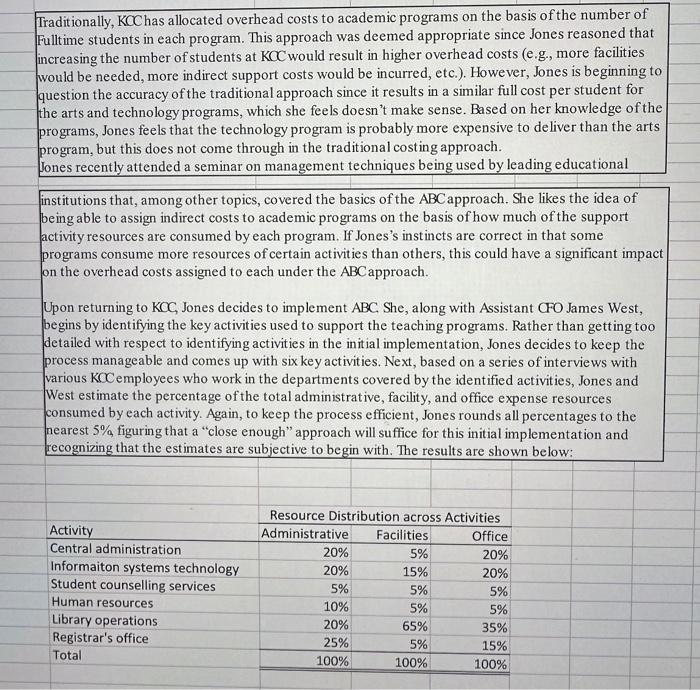a) Using the traditional approach to assigning overhead costs to academic programs: 1) Calculate the predetermined overhead rate. 2) Assign the overhead costs to each academic program using the predetermined rate.
Ic. 3) Calculate the total cost per student (direct costs plus overhead) of operating each academic program.
b) Using ABC, complete the following requirements: 1) Complete the first-stage allocation of overhead costs to academic programs, using exhibit as a guide. 2) Calculate the activity rates for each of the activity cost pools. (Round your answers to 2 decimal places.) 3) Using the activity rates calculated in (b), complete the second stage allocation of overhead to academic programs.
c) Based on the results of (b), calculate the total cost per student (direct costs plus overhead) of operating each academic program. (Round your answers to 2 decimal places.)
Working with key personnel from each of the six activities shown above, Jones and West then identify the activity measure and the quantity of that measure used for each teaching program. Fortunately, KCC implemented an enterprise resource planning system a few years ago, which is already tracking much of the information needed regarding the activity measures and the specific quantities for each academic program: Traditionally, KCChas allocated overhead costs to academic programs on the basis of the number of Fulltime students in each program. This approach was deemed appropriate since Jones reasoned that increasing the number of students at KOC would result in higher overhead costs (e.g., more facilities would be needed, more indirect support costs would be incurred, etc.). However, Jones is beginning to question the accuracy of the traditional approach since it results in a similar full cost per student for the arts and technology programs, which she feels doesn't make sense. Based on her knowledge of the programs, Jones feels that the technology program is probably more expensive to deliver than the arts program, but this does not come through in the traditional costing approach. Jones recently attended a seminar on management techniques being used by leading educational Kolbec Community College ( KCO ) has 4,000 full-time students and offers a variety of academic programs in three areas: professional studies, arts, and technology. The professional studies programs prepare students for administrative and clerical jobs in a variety of professional settings, including accounting, medicine, and law. The arts program's offerings are wide ranging and include graphic design, digital animation, culinary arts, cosmetology, and music arts. The technology programs are also varied, including information technology, medical laboratory technology, electrical engineering technology, pharmacy technology, and natural resources technology. The chief financial officer of KCC, Lynn Jones, has consistently emphasized to other members of the senior management team the importance of understanding the costs of delivering the various academic programs. To that end, the costing system used at KCCtracks the direct costs of each program, which are shown below on an annual basis, along with the number of fulltime students: It is very important to understand the overhead costs consumed by each academic program at KCC in determining the full cost of operating the programs. Central administration at KCCallocates financial resources to academic programs based on the estimated full cost per student of delivering the program. The overhead costs at KCCare significant, totalling over 60% of direct costs. Total annual bverhead costs at KCC are as follows: Working with key personnel from each of the six activities shown above, Jones and West then identify the activity measure and the quantity of that measure used for each teaching program. Fortunately, KCC implemented an enterprise resource planning system a few years ago, which is already tracking much of the information needed regarding the activity measures and the specific quantities for each academic program: Traditionally, KCChas allocated overhead costs to academic programs on the basis of the number of Fulltime students in each program. This approach was deemed appropriate since Jones reasoned that increasing the number of students at KOC would result in higher overhead costs (e.g., more facilities would be needed, more indirect support costs would be incurred, etc.). However, Jones is beginning to question the accuracy of the traditional approach since it results in a similar full cost per student for the arts and technology programs, which she feels doesn't make sense. Based on her knowledge of the programs, Jones feels that the technology program is probably more expensive to deliver than the arts program, but this does not come through in the traditional costing approach. Jones recently attended a seminar on management techniques being used by leading educational Kolbec Community College ( KCO ) has 4,000 full-time students and offers a variety of academic programs in three areas: professional studies, arts, and technology. The professional studies programs prepare students for administrative and clerical jobs in a variety of professional settings, including accounting, medicine, and law. The arts program's offerings are wide ranging and include graphic design, digital animation, culinary arts, cosmetology, and music arts. The technology programs are also varied, including information technology, medical laboratory technology, electrical engineering technology, pharmacy technology, and natural resources technology. The chief financial officer of KCC, Lynn Jones, has consistently emphasized to other members of the senior management team the importance of understanding the costs of delivering the various academic programs. To that end, the costing system used at KCCtracks the direct costs of each program, which are shown below on an annual basis, along with the number of fulltime students: It is very important to understand the overhead costs consumed by each academic program at KCC in determining the full cost of operating the programs. Central administration at KCCallocates financial resources to academic programs based on the estimated full cost per student of delivering the program. The overhead costs at KCCare significant, totalling over 60% of direct costs. Total annual bverhead costs at KCC are as follows










